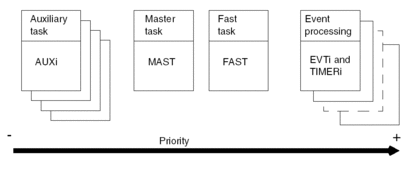Tasks and Processing
The task structure of this type of application is as follows:
Task/Processing |
Designation |
Description |
|---|---|---|
Master |
MAST |
Always present, may be cyclic or periodic. |
Fast |
FAST |
Optional, always periodic. |
Auxiliary |
AUX 0 to 3 |
Optional and always periodic. |
Event |
Called by the system when an event occurs on an input/output module or triggered by the event timer. These types of processing are optional and can be used by applications that need to act on inputs/outputs within a short response time. |
Illustration
The following diagram shows the tasks in a multitasking structure and their level of priority.

Description
The master (MAST) task is still the application base. The other tasks differ depending on the type of PLC.
Levels of priority are fixed for each task in order to prioritize certain types of processing.
Event processing can be activated asynchronously with respect to periodic tasks by an order generated by external events. It is processed as a priority and requires any processing in progress to be stopped.
Subroutine limitations
Subroutines can only be used in one task. For example, MAST subroutines cannot be called from TIMER and EVENT tasks.
Precautions
| CAUTION | |
|---|---|
do them at the same time in the FAST task
mask the FAST task (%S31) while updating


